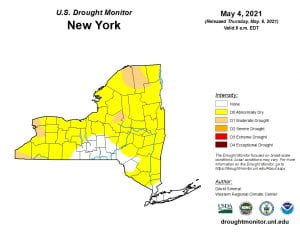We’ve begun our regular height/quality monitoring program this spring on quite a few alfalfa-grass fields across the North Country. Our first report for this week is posted on our website here.
Alfalfa is growing quickly this spring, averaging just over 10” across the region this week. This is ahead of our typical progress at this point in the season. Last year, we measured 5.7” alfalfa this week and just 6.6″, 6.8″, 9.2″ and 6.2″ in 2019, 2018, 2017 and 2016. The first fields to reach peak nutritional quality will be the 90 to 100% grass fields. They were close on Monday and Tuesday this week and may be at peak next week. Peak quality for a 90-100% grass field occurs when the alfalfa is about 14-16” tall.
Very little winter damage to alfalfa was observed this spring, which is a welcomed change from the past couple of years.
Nitrogen should be applied to grass fields (if less than 50% legume and no manure history) very soon, if it’s not already done. Ideally, N should be timed just prior to increase in plant demand for best efficiency and to limit risk of losses to ground and surface water and to the atmosphere.
Betsy Hicks (CCE South Central NY Team) and Joe Lawrence (Cornell PRO-DAIRY) put together some ideas this week for managing first cutting harvest this year, if and when the forage is ready but the field is too wet for field traffic. In a nutshell, as these wet fields become overly-mature, set them aside. They will likely still have value later for non-lactating animals. Focus your harvesting efforts on fields that ARE at target quality. Come back to the overly-mature fields later, when you can. Fully capitalizing on this difference in forage quality also requires the ability to store the hay or haylage separately, however, so they may be fed in an appropriately targeted manner. Joe has called this approach “Dynamic Harvest Scheduling” and he has written about it before – here and here.
The good news about this current wet weather is that it’s helping us inch closer to recovering from the 2020 drought. Areas of abnormally dry and moderate drought conditions across the Northeast improved with the rainfall over the past week. The current map is included here. Click the map for a full Northeast US update from the USDA Drought Monitor scientists. While we remain dry in NNY, our soil moisture conditions have improved with recent rainfall and below average temperatures.
Have a good week and don’t hesitate to reach out to Mike Hunter and I or your local CCE office for more info or help with recommendations.

